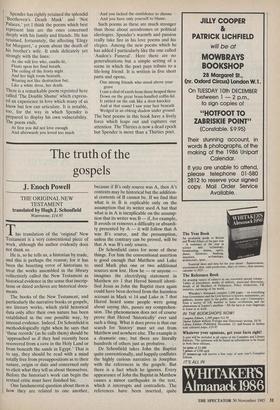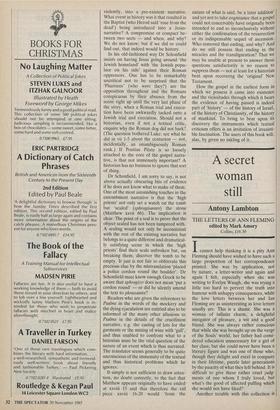The truth of the gospels
J. Enoch Powell
THE ORIGINAL NEW TESTAMENT translated by Hugh J. School&ld
Waterstone,D4.95
This translation of the 'original' New Testament is a very conventional piece of work, although the author evidently does not think so.
He is, so he tells us, a historian by trade, and this is perhaps the reason; for it has been the besetting error of historians to treat the works assembled in the library collectively called the New Testament as historical evidence in the sense that inscrip- tions or dated archives are historical docu- ments.
The books of the New Testament, and particularly the narrative books or gospels, are literary works, which yield historical data only after their own nature has been established in the one possible way, by internal evidence. Indeed, Dr Schonfield is methodologically right when he says that 'these records' (as he calls them) should be 'approached as if they had recently been recovered from a cave in the Holy Land or from beneath the sands in Egypt.' That is to say, they should be read with a mind totally free from presuppositions as to their nature, origin or date and concerned only to elicit what they tell us about themselves. Before the historian's work can begin the textual critic must have finished his.
One fundamental question about them is how they are related to one another, because if B's only source was A, then A's contents may be historical but the addition- al contents of B cannot be. If we find that what is in B is explicable only on the assumption that its writer used A but that what is in A is inexplicable on the assump- tion that its writer was B — if, for example, B avoids or removes a difficulty or absurdi- ty presented by A — it will follow that A was B's source, and the presumption, unless the contrary can be proved, will be that A was B's only source.
Dr Schonfield cares for none of these things. For him the conventional assertion is good enough that Matthew and Luke used Mark plus one or two additional sources now lost. How he — or anyone — imagines the electrifying statement in Matthew xiv 1 that Herod himself identi- fied Jesus as John the Baptist risen again could have been derived from the harmless account in Mark vi 14 and Luke ix 7 that Herod heard some people were going about saying this, passes my comprehen- sion. The phenomenon does not of course prove that Herod 'historically' ever said such a thing. What it does prove is that our search for 'history' must set out from Matthew and nowhere else. The example is a dramatic one; but there are literally hundreds of others just as probative. , Dr Schonfield takes John the Baptist quite conventionally, and happily conflates the highly curious narrative in Josephus with the references in the gospels. But there is a fact which he ignores. Every, appearance of John the Baptist in Matthew causes a minor earthquake in the text, which it interrupts and contradicts. The references have been inserted, quite violently, into a pre-existent narrative. What event in history was it that resulted in the Baptist (who Herod said 'rose from the dead') being introduced into a Jesus- narrative? A compromise or compact be- tween two sects — and when, and why? We do not know; but if we did or could find out, that indeed would be history.
In his old-fashioned way Dr Schonfield insists on having Jesus going around 'the Jewish homeland' with 'the Jewish popu- lace on his side' against their Roman oppressors. One has to be remarkably uncritical not to be surprised that the 'Pharisees' (who were they?) are the opposition throughout and the Romans conspicuous by their absence from the scene right up until the very last phase of the story, when a Roman trial and execu- tion have been awkwardly tacked onto a Jewish trial and execution. Should not a historian, even if not a textual critic, enquire why the Roman dog did not bark? (The question bothered Luke: see what he did in vii 1-5 about the centurion — not, incidentally, an unambiguously Roman rank.) If Pontius Pilate is so loosely attached to the core of the gospel narra- tive, is that not immensely important? A historian has no business to ignore that sort of thing.
Dr Schonfield, I am sorry to say, is not above actually obscuring bits of evidence if he does not know what to make of them. One of the most astonishing touches in the entombment narrative is that the 'high priests' not only set a watch off the tomb but 'sealed' (sphragisantes) the stone (Matthew xxvii 66). The implication is clear. The point of a seal is to prove that the object sealed has not been tampered with. A sealing would not only be inconsistent with the rest of the existing narrative but belongs to a quite different and dramatical- ly satisfying scene in which the 'high priests' find their seals unbroken but, on brealcing them, discover the tomb to be empty. It just is not fair to obliterate this precious clue by the mistranslation 'placed a police cordon round the boulder'. Dr Schonfield must know enough Greek to be aware that sphragizo does not mean 'put a cordon round' — or did he silently amend the text to phraxantes?
Readers who are given the references to Psalms in the words of the mockery and the dying ejaculation are entitled also to be informed of the many other allusions to Psalms in the details of the crucifixion narrative, e.g. the casting of lots for the garments or the mixing of wine with 'gall', and thus enabled to confront what to a historian must be the vital question of the nature of an event which is thus narrated. The translator seems generally to be quite unconscious of the immensity of the textual and thus historical problems which he ignores.
It simply is not sufficient to draw atten- tion, no doubt correctly, to the fact that Matthew appears originally to have ended at xxviii 15 and that therefore the , tail piece xxviii 16-20 would `from the nature of what is said, be a later addition' and yet not to take cognisance that a gospel could not conceivably have originally been intended to end so inconclusively without either the confirmation of the resurrection or its indispensable sequel of ascension. Who removed that ending, and why? And do we still possess that ending in the miracles and the transfiguration? That we may be unable at present to answer those questions satisfactorily is no reason to suppress them — not at least for a historian bent upon recoverng the 'original' New Testament.
How the gospel in the earliest form in which we possess it came into existence and the vicissitudes through which it bears the evidence of having passed is indeed part of 'history' — of the history of Israel, of the history of Christianity, of the history of mankind. To bring to bear upon its discovery the instruments which textual criticism offers is an invitation of irresisti- ble fascination. The users of this book will, alas, by given no inkling of it.



























































 Previous page
Previous page